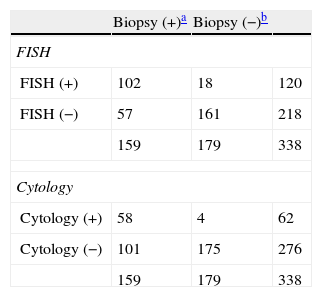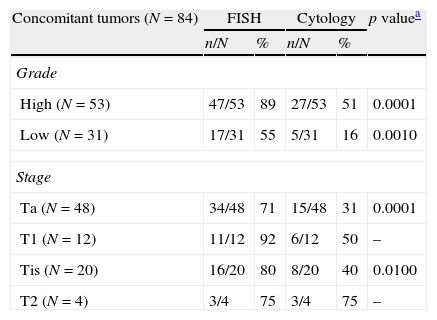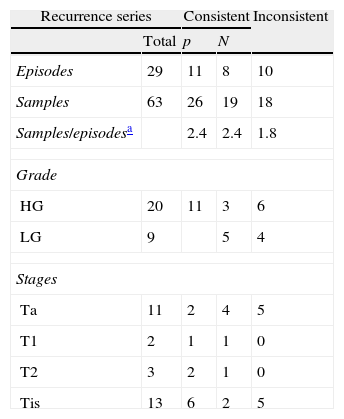To assess the value of the study of chromosomal alterations by fluorescent in situ hybridization in a series of patients diagnosed of urothelial carcinoma and a minimum follow-up of twenty-four months, as well as evaluate its putative predictive potential.
Materials and methodsThe overall series includes 338 samples from 98 patients with 84 episodes of urothelial carcinoma. A subgroup of 24 patients who had at least one recurrence during the follow-up was used to evaluate the predictive potential of the test. Three categories were considered (positive coherent episode, negative coherent episode, and incoherent episode) depending on the relationship between the fluorescent in situ hybridization result in the concomitant study of the new episode and those of the preceding samples.
ResultsFluorescent in situ hybridization showed higher sensitivity regardless of grade, negative predictive value and accuracy, while specificity and positive predictive value were superior with conventional cytology. In the recurrence, series 19/29 episodes were coherent, 11/19 were positive coherent with urothelial carcinoma all high grade and 8/19 negative coherent, most low grade.
ConclusionsFluorescent in situ hybridization test shows good sensitivity during a follow-up of twenty-four months and is able to predict recurrence, especially in cases of high grade. Our data demonstrate the existence of urothelial carcinomas without detectable chromosomal abnormalities by currently available methodology. The results support a multidisciplinary follow-up combining fluorescent in situ hybridization, cytology and cystoscopy.
Evaluar la utilidad del estudio de alteraciones cromosómicas mediante hibridación in situ fluorescente en una serie de pacientes diagnosticados de carcinoma urotelial con un seguimiento mínimo de 24 meses, y analizar su posible efecto anticipador.
Material y métodosLa serie global incluye 338 muestras procedentes de 98 pacientes con 84 episodios de carcinoma urotelial. Para evaluar la capacidad de predicción del test se estudió un subgrupo de 24 pacientes que presentaron como mínimo una recurrencia a lo largo del seguimiento (serie de recurrencia). Se consideraron 3 categorías (episodio coherente positivo, episodio coherente negativo y episodio no coherente) en función de la relación entre los resultados de la hibridación in situ fluorescente del estudio concomitante al nuevo episodio y las muestras precedentes.
ResultadosLa hibridación in situ fluorescente presentó mayor sensibilidad independientemente del grado, valor predictivo negativo y exactitud, mientras que la especificidad y el valor predictivo positivo fueron superiores para la citología convencional. En la serie de recurrencia 19/29 episodios resultaron coherentes, 11/19 fueron coherentes positivos, todos con carcinoma urotelial de alto grado, y 8/19 coherentes negativos, la mayoría de bajo grado.
ConclusionesLa hibridación in situ fluorescente muestra una alta sensibilidad en un seguimiento de 24 meses, y es capaz de predecir recurrencias, especialmente en casos de alto grado. Nuestros datos demuestran también la existencia de carcinomas uroteliales sin alteraciones cromosómicas detectables con la metodología actualmente disponible. Los resultados apoyan un seguimiento multidisciplinar con la utilización combinada de la hibridación in situ fluorescente, citología y cistoscopia.











